Peter MALONE
Saturday, 18 September 2021 19:41
Third Degree Burn
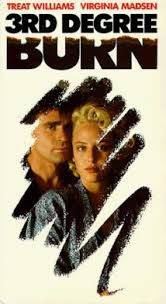
THIRD DEGREE BURN
US, 1989,100 minutes, Colour.
Treat Williams, Virginia Madsen, Richard Masur, C.C.H. Pounder.
Directed by Roger Spottiswoode.
Third Degree Burn is a smooth thriller made for home box-office television. It is made with style, directed by Roger Spottiswoode (Terror Train, Under Fire, Shoot to Kill).
Treat Williams is believable as the debonair ex-policeman, private detective who is infatuated and falls in love with the innocent and beautiful blonde. (He worked with Spottiswoode in The Pursuit of D.B. Cooper.) Virginia Madsen is the wealthy attractive and lonely wife who falls in love - and turns out to be, of course, the unscrupulous and ruthless femme fatale - who may just have fallen in love with the hero but can't turn back. Richard Masur (who worked with Spottiswoode in Shoot to Kill) is the ex-detective who helps her in her plot.
The film moves at a leisurely pace, the audience identifying with Williams, seeing Anne as innocent, sharing his falling in love. When the expected happens, he is caught. The screenplay is obviously a variation on Double Indemnity - with Williams as the Fred MacMurray? character and Virginia Madsen, very effective, in the Barbara Stanwyck role.
A good murder mystery thriller.
1. Interesting thriller, mystery, romance?
2. The world of Seattle, Tucson Spa? The city. the affluent spa, the desert scenery? Authentic atmosphere for the action? The score and its mood?
3. The title, the references to Scott, crime and punishment?
4. The sketch of Scott: the initial sexual encounter, the husband returning (and his telling stories of Scott's past), the fight with the policeman husband. his being an ex-policeman)? The break-up of his marriage with Julie, the great friendship with her, with Art, getting a job? Seeing Scholes? To Tucson, the plush spa, watching Anna, the photos, her swimming, unwillingly meeting her in the desert and helping her with the car, at the table, the sexual encounter, the sharing with her and her life, the affair, allowing himself to be discovered by her? Her breaking the affair? Giving the photos back to Scholes, keeping one, the chance meeting. beginning again. being photographed? Anne calling him a fool for love?
5. His office being robbed, the attitudes of the police, the set-up in the house, finding the body, the arrest? His denials, his skill in escaping, disguise, tracking down the camera and the photo? Telling Anne, meeting her, the decision to trust her or not, sexual encounter, the phone call, going to play? The talk, taping it, the shot? Anne's behaviour, her lies, Scott's chasing her and her crash? His future?
6. Anne as lovely, alone in the desert, the build-up and the background, the swimming, the car breakdown, the meal, the sex, audiences and Scott believing her innocence? Her saying she was ashamed, denying it, renewing the relationship? The audience's view of her for the credibility of the film? The death, questioned by the police, Scott meeting her, the phone call, the truth with Clay, shooting Clay, her crash and death? No loyalty?
7. Clay and his disguise, the revelation, how he was recruited and seduced, the truth, his death?
8. Julie and her love for Scott, helping him with jobs, with investigations, the police work, Art and his friendship and jobs?
9. The hostile police, the arrest, the escape techniques, police angers, evidence?
10. A film noir of the '80s? Human nature, deceit, violence, greed ? and love? Betrayal by love?
Published in Movie Reviews
Published in
Movie Reviews
Tagged under
Saturday, 18 September 2021 19:41
Two Weeks with Love
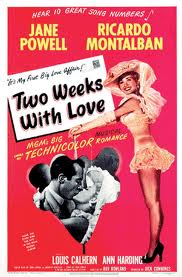
TWO WEEKS WITH LOVE
US, 1950, 92 minutes, Colour.
Jane Powell, Ricardo Montalban, Louis Calhern, Anne Harding, Phyllis Kirk, Carleton Carpenter, Debbie Reynolds, Clinton Sundberg, Tommy Rettig.
Directed by Roy Rowland.
Two Weeks with Love was a very popular musical in its time. It was one of the many musicals around 1950 which took audiences back to the nostalgic times of the first decade of the 20th century (films like Doris Day’s On Moonlight Bay and By the Light of the Silvery Moon, stories by Booth Tarkington).
Louis Calhern and Anne Harding as the parents take their children to the Catskills for two weeks’ holiday. Their eldest daughter, Patti, Jane Powell, is about to turn eighteen – mother tries to keep her as a little girl, she wants to break out and become a woman. Debbie Reynolds is her younger sister. Ricardo Montalban is the Cuban who becomes the heartthrob.
Jane Powell was very popular in MGM musicals at this time, making several a year – and was to ultimately make a big hit in such films as Seven Brides for Seven Brothers. Ricardo Montalban had come from Mexico and appeared with Esther Williams in Fiesta and was a contract player at MGM. Debbie Reynolds had appeared in some musicals at Warner Bros but this was her breakthrough film at MGM, especially singing “Abba Dabba Honeymoon” with Carleton Carpenter. She was soon to make Singin’ in the Rain and have a very successful career in musicals and in comedy.
The film was directed by Roy Rowland who made a number of programmer films at MGM but also directed such musicals as Hit the Deck and Meet Me In Las Vegas.
1. An enjoyable piece of Americana, the quality of the film as musical and comedy?
2. Representing the style of 1950, a Jane Powell vehicle, choreography by Busby Berkley, use of colour, period costumes and settings and atmosphere?
3. The importance of the nostalgia for the insight into America at the turn of the century? The nostalgia for this particular period? Sentiment in the presentation of families, memories of youth, growing up? The significance of the title and its connection with Patty?
4. The family themes in the film: the presentation of adolescence and childhood, the emphasis on adolescent girls? The presentation of the realities and the problems of growing up? Audience response to this, sympathy with the adolescent problems, age and the distance of time and the problems seeming so important at the moment, the irony of parents growing up and older, the nostalgia of the memories of their adolescence? How well presented in the framework of a musical comedy?
5. The recreation of the period and its way of life: the opening with the band, the music and the songs, Patty and her song? The preparations for the holiday, formalities, the type of holiday, the holiday hotel itself, the meals, propriety, the concerts and the rowing, the drug stores in the town? The importance of manners and behaviour in this period? Good form? The values of this older way of life?
6. The presentation of the parents? An amiable father, his niceness, his prim and proper outlook on life, his proneness to attacking the irony of his overhearing the conversation about youth? The humour of his trying to give his children something? The humour of the surgical corset? The presentation of the mother and her values, keeping her children as little girls, the clash with the father over the issue and the story about Beulah? Her changing her mind and helping her daughter at the end? The importance of the affectionate scenes between husband and wife, a pattern of parents for example at the rowing?
7. The film's focus on Patty and Jane Powell's performance? A girl at 17, her wanting to grow up, considering herself a woman, clothes and the corset as a symbol of this? Her attitude towards boys and looking down on Billy? The importance of showing her awkwardness and her gaffes especially in the dining room, her hiding in the various places? The contrast with Melba as the younger adolescent? The scene of her disdain of Billy and his pressing his suit? Her niceness towards him at the end? The importance of Dan as ideal in her eyes, a big thing at the time? Her following him round and her being thwarted by Valerie? Her believing Valerie’s stories and pretending to be a vamp? Her falling into the lake and swimming, the horse and the blanket, the confrontation with her father? The humour of the fantasies especially that in the rowing boat? The importance of her dream and its being a musical comedy? The contrast with Valeric as the self-centred older woman? The humiliation, The crises and the moodiness? The build-up to the tango and the final permission for Dan to court her? How accurate a picture of a girl growing up?
8. The contrast with Melba and the teenage crushes, her pursuit of Billy, the song and dance routines? Debbie Reynolds' style?
9. The ironic presentation of Valerie, her career, her vanity, her swooning into Dan’s arms and then tricking Patty, her plans, her final comeuppance?
10. The presentation of Billy and his gawkiness, devotion to Patty, disdain of Melba, his relationship with his father and short pants?
11. Dan as the romantic figure, an heroic mould here, his niceness, his courtesy to Patty and his humour? His toleration of Valerie? His roles in Patty's fantasies? The culmination with the tango and his paying court to her?
12. The film's use of music, songs and the old nostalgic tunes, the comic songs especially with Melba, the Oceana Roll and Abba, Dabba Dabba? The dramatisation of 'The Chocolate Soldier' and involving the whole cast in this fantasy?
13. To what audience did the film make its appeal? How could audiences identify with the characters and the themes? The nostalgic style and humour to capture the audiences? A success within its conventions?
Published in Movie Reviews
Published in
Movie Reviews
Tagged under
Saturday, 18 September 2021 19:41
Tiger in the Smoke
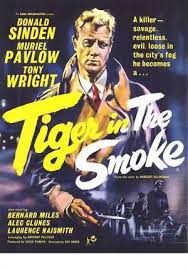
TIGER IN THE SMOKE
UK, 1956, 94 minutes, Black and white.
Donald Sinden, Muriel Pavlow, Tony Wright, Bernard Miles, Alec Clunes, Laurence Naismith.
Directed by Roy Baker.
Tiger in the Smoke is an effective crime thriller of the mid-50s, a glimpse of the London streets and crime elements and gangs. It foreshadows the period of the Krays and other gangs in London. These were visualised in two films by Peter Medak, The Krays and Let Him Have It, the story of Derek Bentley who was executed for the murder of a policeman.
Tony Wright is the leader of the gang, Bernard Miles, in an unusual role, portraying the older gang leader. There are religious issues with Laurence Naismith as the local Canon. Donald Sinden and Muriel Pavlow are the stars, an ordinary group of citizens harassed by the Tigers in the Smoke. Alec Clunes is the policeman.
The film was directed by Roy Ward Baker who had tried his hand in Hollywood with such films as Don’t Bother to Knock and Inferno. In later decades he was to direct several horror films in his native England.
1. The significance and tone of the title? Was it verified in the film? The success of the film as a thriller? Its use of thriller conventions?
2. How enjoyable as a thriller was the film? Did it grip its audience? How?
3. How did the film create and rely on its atmosphere? The use of fog, the London environment, blackmail and use of railway stations, the band and their place of living, the sense of menace, the varying angles and panning shots? The contrast with the clarity of France? Was this a major contribution to the film?
4. How important was the theme of war and Its impact on peoples greed? The theme of greed and obsession? Johnny Cash as a child, greedy, as a man murdering for greed., the relentlessness of his final seeking the treasure? The theme of violence and blackmail and evil planning? The discussion by the police on an evil man?
5. The importance of Mrs. Cash and her presentation in the film? The personification by the actress? The discussions of her role in peoples lives? Her influence on Johnny? Its repercussions on the Canon?
6. The significance of the portrayal of the group? Their work, their greed, their relentlessness, their violence and madness? The idiosyncrasies of each person?
7. How interesting were the hero and heroine? Their portrayal - ordinary or different? The human situations of marriage, blackmail, love and marriage, danger and threats, the influence of Martin on them both via the letter and the treasure? The contrast between them and the villains?
8. What did the Canon add to the film? His character and personality? the helping the police and Meg? The significance of his talk with Johnny Cash? His pursuit of death? The science of luck? Should he have stayed to be wounded? Risking his life?
9. How well portrayed were the police? The ordinary police and the Superintendent? The attempts at their work, the fog, the leads? How important are the police in British thrillers?
10. How important was the interaction of characters for this film? Havock's influence before seeing him, the deaths, scaring Meg, his reactions with the group, with the Canon, the ending? The interaction of Leavitt with the gang?
11. How successful was the suspense? Was the climax appropriately dramatic or melodramatic? How successful was the film as a whole?
Published in Movie Reviews
Published in
Movie Reviews
Tagged under
Saturday, 18 September 2021 19:41
Two Tickets to Broadway
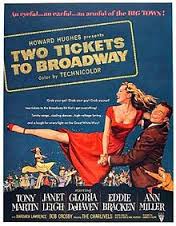
TWO TICKETS TO BROADWAY
US, 1951, 106 minutes, Colour.
Janet Leigh, Tony Martin, Gloria de Haven, Ann Miller, Bob Crosby, Eddie Bracken.
Directed by James V. Kern.
Two Tickets to Broadway is a run of the mill musical of the fifties. It is notable as being a vehicle for Janet Leigh, under the patronage and production of Howard Hughes. The choreography, which is not particularly startling, is by the veteran Busby Berkeley. Ann Miller gets a chance to dance and Tony Martin sings.
1. How enjoyable a musical? Its status in the line of Hollywood musicals of the 50's ? A Howard Hughes production? Tony Martin and his popularity, Janet Leigh? Bob Crosby? The focus on Broadway and the transition to television? The early days of television? Busby Berkley and his staging of the musical numbers?
2. The music, the genre: the conventions e.g. Nancy's farewell, the troupe of dancers failing and trying to make good on Broadway, Nancy and her ambitions, being tricked, final success? Dan as typical hero, struggle, success? The agent with his lying and his comedy? The musical numbers, the introduction of the songs and their re-play? Better than usual?
3. Colour photography, sets, choreography and music?
4. The basic American plot: small town girl comes to the city, falls in love, tries to make good? Struggle with friends? Serious and comic people? The lucky break? How conventionally American? The convention of American dream?
5. Dan as the typical American hero, singer? Nancy as the naive young girl from the country learning from experience in the city? Her falling in love, the link with the dances? The character of her friends? The nastiness in the comedy with the agent?
6. Any special highlights of this particular musical as illustrating the types of musicals of the fifties?
Published in Movie Reviews
Published in
Movie Reviews
Tagged under
Saturday, 18 September 2021 19:41
13 Rue Madeleine
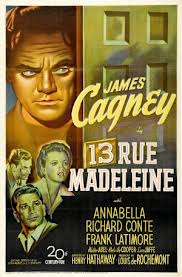
13 RUE MADELEINE
US, 1946, 95 minutes, Black and white.
James Cagney, Annabella, Richard Conte, Frank Latimore, Walter Abel, Melville Cooper, Sam Jaffe.
Directed by Henry Hathaway.
13 Rue Madeleine is a semi-documentary-style drama about espionage during World War Two. It focuses on the formation of the OSS, its training, infiltration by German spies, counter-espionage in feeding false information to the traitor and the unmasking of the traitor.
James Cagney has an interesting role as the leader of the team, a remove from his gangster-like characters. Richard Conte is the spy, giving an interesting performance as well, undercover, the traitor.
The film is material that was shown in quite a number of films of the period including the American OSS with Alan Ladd and Geraldine Fitzgerald. Subsequently, many films have been made about espionage during the war as well as tributes to those who worked undercover including Odette and Carve Her Name With Pride.
Director Henry Hathaway had a career of directing for over forty years. Beginning in the 1930s, he directed a number of action adventures including the first Technicolor western, Trail of the Lonesome Pine. He directed a number of action adventures also during the 40s but after the war a few semi-documentary films like this one and Call Northside 777 and The House on 92nd Street. He also made The Desert Fox, the story of Rommel, with James Mason. With the coming of Cinemascope he made colourful action adventures including Prince Valiant and Garden of Evil. He also directed John Wayne to his Oscar-winning performance in True Grit.
1. The impact of the film in 1946, now? The reason for the differences? Interesting, entertaining?
2. The film's semi-documentary style, black and white photography, attention to detail, times and post-World War II atmosphere? Response to this kind of semi-documentary feature? The film as propaganda?
3. The background of the war, the atmosphere, for Americans, the issues of World War II, the need for allied victory? The film’s fairness?
4. The atmosphere of war, the background for espionage, the issues of espionage, legality and morality? The stances that the film took? Their justification?
5. The documentary presentation of how people were chosen and selected for espionage work?
6. The importance of the details of training? Its demands, as hard, response of those involved? The atmosphere of the unknown, the dedication and patriotism?
7. The training of men and women and their varying roles? The effects on the character of each individually, as they worked with one another? For future use during actual espionage work?
8. Bob Sharkey, James Cagney's performance? Watching the processes through his eyes? The hero of the film? The reasons for his dedication and involvement? Relating with others?
9. The attention to the other characters? The credibility of these characters involved in espionage? The effect of training on them? Especially Bill O'Connell?
10. Audience interest in the mission, the immediate preparations and the details in England? landing in Europe? The threats and risks of the espionage work? The results of training and skill, violence?
11. The issues of traitors? The revelation Of Bill O'Connell? His character well developed? Audience response to the traitor?
12. The action sequences and their success for action drama?
Published in Movie Reviews
Published in
Movie Reviews
Tagged under
Saturday, 18 September 2021 19:41
Murmur of the Heart/ La Souffle au Coeur
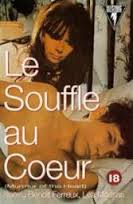
MURMUR OF THE HEART (LE SOUFFLE AU COEUR)
France, 1971, 122 minutes, Colour.
Lea Massari, Benoit Ferraux, Daniel Gelin.
Directed by Louis Malle.
Murmur of the Heart is a French comedy of manners, 50's style. Although this film was made in 1971 the permissiveness and sexual sequences would have been rather daring had it been shown 20 years earlier. This film could create an interesting discussion on the change in society and its outlook from the 50's to the present day.
1. This was a comedy of manners, French 50's style. How seriously was it meant to be taken?
2. Did you feel that this was an accurate and perceptive re-creation of the lifestyle and attitudes of people like those of Dijon at the time? How did the film take the trouble to make the reconstruction accurate? Did the film aid in the understanding of the mentality of the times? (Note the Indo-China? war situation).
3. How ordinary a family were the Chevaliers? How typical were their attitudes and behaviour? The professional work of the father, his distance from his sons, relationship with his wife? The wife, her Italian background, young, with lovers, doting on her children especially Laurent? Marc and Thomas ? adolescence, average intelligence, sexually curious? Laurent ? serious, reading Camus, stealing Charlie Parker records, love for his mother, serving Mass yet non-religious, sexually developing, delicate health?
4. How were the family relationships shown in the film, meals, overheard conversations, the boys fooling around in their mother's room, fooling around together?
5. Who was the main character in this film? Why?
6. What role did religion play in this family life ? Mass, Confession, going to a Catholic school? Did religion have any real influence on or relevance to them?
7. The family took sexuality lightly, How important was sexuality in the film? The film was certainly not puritanical. Was it permissive?
8. Did Laurent change much during the film? Schoolboy. young, at his brother's party (drink, smoke, kiss), studies. illness and being looked after, his experience at the Spa, Helen, sophistication, his relationship with his mother (disappointed in her infidelity to him), the incest sequence? The film did not take this sequence over seriously, was this right? Was the agreement between mother and son the best way to handle the situation?
9. What of the ending and the laughter at Laurent?
10. This family and film seem very 'worldly'. Was the film just a mirror of France at that time; a mirror of the world and nothing more?
Published in Movie Reviews
Published in
Movie Reviews
Tagged under
Saturday, 18 September 2021 19:41
Murder that Wouldn't Die/ 1980

MURDER THAT WOULDN'T DIE
US, 1980, 97 minutes, Colour.
William Conrad, Jose Ferrer, John Hillerman, Sharon Acker, Kenneth Tobey.
Directed by Ron Satlof.
The Murder That Wouldn't Stay Dead is a reasonably enjoyable telemovie. It was co-written by Glen Larson, writer and producer of so many television series at Universal Studios.
The film is a star vehicle for William Conrad. He is supported by a television cast and some guest stars including Jose Ferrer and John Hillerman.
The film has attractive Hawaiian settings, has a case of 1942 having its influence in 1980 ? and being resolved.
The film is an entertaining whodunnit, American style.
1. Entertaining telemovie? An amiable presentation of human nature? movie? Whodunnit? Characters? Mystery? Clues? Resolution?
2. The use of Hawaiian settings? Attractive? Authentic? Musical score? Editing and pace? The black and white photography of the 1940s? The restaurant, the Andrew Sisters? Court case? Black and white photography contrived for the film?
3. The title, indication of murder mystery? William Battle and his investigation?
4. William Conrad's style as Battle? Abrasive, sure ingenious? His brother's death? His return to Hawaii? Police background? Security job? Past relationship with Nancy? Friendship with Deacon? Helping Shelby? Getting TuZi? on the team? His special team, their tactics? The interviews with the suspects? The night out, nightclubs, the doctor and his wife, deep sea fishing? The photographing of Briggs, documentation? The dramatic set-up at the restaurant? The pursuit by Briggs? The finale of the football match?
5. Deacon and his studies, sport? His love for Shelby? Suspicions of Battle? The fire at the archives? Helping with the investigations? The sidekick character? Final sport victory? Shelby and her love for her father, helping, the re-enactment?
6. Tull and his criminal background, ingenuity, high kicks? On the football team?
7. The Coach and the comic touches? The Dean and her friendship with Battle, 20 years, her mother's influence, reunion?
8. Briggs and his investigations, his inner sanctum with the documentation? His removing the newspaper? At the re-enactment? His lies? Blackmail, the confrontation with Battle?
9. Ames and his role in the Hawaiian Police? Jensen as a retired General, deep sea fisherman? The PR man and their friendship? His smooth manner with Battle? Harrison and his work on the paper? Their not telling the truth? The re-enactment, the truth and the memory?
10. The doctor and his helping Battle's brother? Death and the overdose? His wife and her concern? The revelation of her identity?
11. The background of the war, marriage, infidelity, drunkenness, the rape situation, the blaming of the four Hawaiians, their being found not guilty, the victim's mother and the murder, the pardon from Washington? The upper classes of Hawaii?
12. Themes of human nature, passion and greed? Blackmail? The investigation and the resolution?
Published in Movie Reviews
Published in
Movie Reviews
Tagged under
Saturday, 18 September 2021 19:41
Murder or Mercy/ 1974
MURDER OR MERCY
US, 1974, 74 minutes, Colour.
Melvyn Douglas, Bradford Dillman, Denver Pyle, Mildred Dunnock, David Birney, Don Porter, Robert Webber, Kent Smith. Directed by Harvey Hart.
Murder or Mercy is an interesting and arresting telemovie. Its subject is euthanasia. The film was written by Douglas Day Stewart who was to write such films as The Blue Lagoon and An Officer and a Gentleman as well as write and direct Thief of Hearts. They tended to be romanticised films. This one is much more realistic. It is well served by its cast: Melvyn Douglas giving dignity and credibility to the central character, the doctor who makes the decision to end his wife's life. Mildred Dunnock is the wife. Bradford Dillman is good as a lawyer and Denver Pyle, noted more for his action roles, is a crusty old lawyer, his father. The film is brief in its running time but raises many issues and dramatises them very well.
1. The impact of the telemovie? For the home audience? For interruption by commercials, a serious topic and moral consciousness-raising at the home audience level?
2. The American atmosphere of the film? For American audiences? For universal audiences? The contemporary scene of hospitals, prison, courts?
3. The credibility of the plot, the situations, characters? Exploration of moral stances, principles, emotional response? Legal issues? Judicial decisions?
4. Audience attitudes towards euthanasia, to mercy killing? The role of the patient in determining his or her own life and death? Moral obligations? The patient and choices? ordinary and extraordinary means for the preserving of life? Medical technology and its developments, impositions on human dignity? The responsibility of the person who makes the decision to terminate a life?
5. Themes of the quality of life, of existence, human dignity? The prolonging of life, the nature of death, the heart and the brain ceasing to function? Medical definitions of death? Legal definitions of death?
6. The screenplay and the points of view? An intelligent presentation of the issues? Eliciting emotional response? The situation of the patient and her not wanting to live? Her request? Her will? The doctor with his knowledge of the medical and technological situation? Reverence for life? The hospitals and the wards? The means to keep a person alive, using them or not? The criticism of a mercy killer playing God? The comment on illnesses e.g. strokes as signs from God that a life is coming to an end?
7. Lois and Paul, the initial sketch of their relationship, their mutual love, the book and the inscription? The interview with the doctor? The news about the terminal illness? Lois going to hospital, her strokes. her pain. the pact and her husband to kill her?
8. Paul as a doctor, his love for his wife, his having lectured on medicine and ethics? His grief at his wife's suffering? Hesitation? The pact between husband and wife? His turning off the machine? His withdrawing the means for her life? His comment about killing his wife? The arrest. his not wanting to defend himself, not wanting a lawyer? The end of his life with the death of his wife? Prison and his hunger strike? Sam's visit and questions? Amos and his friendship? The legal examination of the situation, especially about the nature of the will? The discussions about the plea, the discussion about diminished responsibility? Paul out on bail, his own worry, his decision to take the pills and end his life? his last minute change of mind and heart, winning Amos? The use of this last moment change in evidence against him? His fighting for his life? The experience of the trial, his disagreement with the diminished responsibility plea? His speech about belief in God, his own principles, ordinary means for preserving life? His expertise and experience?
9. Sam and the law, his relationship with his father and tricking him into interest in the case, discussing the parallels between Amos and Paul? Amos and his retirement, vegetating? Interest in the case, the plea, agreeing with Paul? Their conduct of the case? Sam's use of diminished responsibility? The attempted suicide and their coming to the rescue? The interview with medical personnel? With Dr. Peterson and his efforts to save life ~ at what cost? Amos and his speech? The plea for the right to die with dignity? The law to acknowledge this?
10. The picture of the doctors: Dr. Peterson and his admiration for Paul, his taking Sam on the tour of the hospital, his moral stance about the termination of life? The contrast with Dr. Stoneman and his belief in developments of technology, his rigorous pursuit of the saving of life (what kind of life)? The nurse and her evidence? Experts pro and con? The film's audi6nce having to make up their minds from the evidence and the speeches?
11. Ballan and his interest in the case, the conduct of the case, the clash with the Champions? His lines of interrogation and his attitude towards Paul's attempted suicide?
12. The role of the judge, listening to the evidence, to the decisions and the administration of the trial? The jury, their deliberations, their verdict? The discrepancies in law from American state to state?
13. The use of the telemovie to portray varying points of view, dramatise these, offer audience reflections on the quality of life?
US, 1974, 74 minutes, Colour.
Melvyn Douglas, Bradford Dillman, Denver Pyle, Mildred Dunnock, David Birney, Don Porter, Robert Webber, Kent Smith. Directed by Harvey Hart.
Murder or Mercy is an interesting and arresting telemovie. Its subject is euthanasia. The film was written by Douglas Day Stewart who was to write such films as The Blue Lagoon and An Officer and a Gentleman as well as write and direct Thief of Hearts. They tended to be romanticised films. This one is much more realistic. It is well served by its cast: Melvyn Douglas giving dignity and credibility to the central character, the doctor who makes the decision to end his wife's life. Mildred Dunnock is the wife. Bradford Dillman is good as a lawyer and Denver Pyle, noted more for his action roles, is a crusty old lawyer, his father. The film is brief in its running time but raises many issues and dramatises them very well.
1. The impact of the telemovie? For the home audience? For interruption by commercials, a serious topic and moral consciousness-raising at the home audience level?
2. The American atmosphere of the film? For American audiences? For universal audiences? The contemporary scene of hospitals, prison, courts?
3. The credibility of the plot, the situations, characters? Exploration of moral stances, principles, emotional response? Legal issues? Judicial decisions?
4. Audience attitudes towards euthanasia, to mercy killing? The role of the patient in determining his or her own life and death? Moral obligations? The patient and choices? ordinary and extraordinary means for the preserving of life? Medical technology and its developments, impositions on human dignity? The responsibility of the person who makes the decision to terminate a life?
5. Themes of the quality of life, of existence, human dignity? The prolonging of life, the nature of death, the heart and the brain ceasing to function? Medical definitions of death? Legal definitions of death?
6. The screenplay and the points of view? An intelligent presentation of the issues? Eliciting emotional response? The situation of the patient and her not wanting to live? Her request? Her will? The doctor with his knowledge of the medical and technological situation? Reverence for life? The hospitals and the wards? The means to keep a person alive, using them or not? The criticism of a mercy killer playing God? The comment on illnesses e.g. strokes as signs from God that a life is coming to an end?
7. Lois and Paul, the initial sketch of their relationship, their mutual love, the book and the inscription? The interview with the doctor? The news about the terminal illness? Lois going to hospital, her strokes. her pain. the pact and her husband to kill her?
8. Paul as a doctor, his love for his wife, his having lectured on medicine and ethics? His grief at his wife's suffering? Hesitation? The pact between husband and wife? His turning off the machine? His withdrawing the means for her life? His comment about killing his wife? The arrest. his not wanting to defend himself, not wanting a lawyer? The end of his life with the death of his wife? Prison and his hunger strike? Sam's visit and questions? Amos and his friendship? The legal examination of the situation, especially about the nature of the will? The discussions about the plea, the discussion about diminished responsibility? Paul out on bail, his own worry, his decision to take the pills and end his life? his last minute change of mind and heart, winning Amos? The use of this last moment change in evidence against him? His fighting for his life? The experience of the trial, his disagreement with the diminished responsibility plea? His speech about belief in God, his own principles, ordinary means for preserving life? His expertise and experience?
9. Sam and the law, his relationship with his father and tricking him into interest in the case, discussing the parallels between Amos and Paul? Amos and his retirement, vegetating? Interest in the case, the plea, agreeing with Paul? Their conduct of the case? Sam's use of diminished responsibility? The attempted suicide and their coming to the rescue? The interview with medical personnel? With Dr. Peterson and his efforts to save life ~ at what cost? Amos and his speech? The plea for the right to die with dignity? The law to acknowledge this?
10. The picture of the doctors: Dr. Peterson and his admiration for Paul, his taking Sam on the tour of the hospital, his moral stance about the termination of life? The contrast with Dr. Stoneman and his belief in developments of technology, his rigorous pursuit of the saving of life (what kind of life)? The nurse and her evidence? Experts pro and con? The film's audi6nce having to make up their minds from the evidence and the speeches?
11. Ballan and his interest in the case, the conduct of the case, the clash with the Champions? His lines of interrogation and his attitude towards Paul's attempted suicide?
12. The role of the judge, listening to the evidence, to the decisions and the administration of the trial? The jury, their deliberations, their verdict? The discrepancies in law from American state to state?
13. The use of the telemovie to portray varying points of view, dramatise these, offer audience reflections on the quality of life?
Published in Movie Reviews
Published in
Movie Reviews
Tagged under
Saturday, 18 September 2021 19:41
Murder on the Orient Express
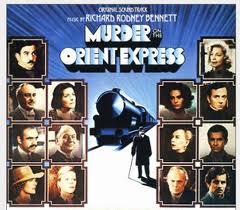
MURDER ON THE ORIENT EXPRESS
UK, 1974, 131 minutes, Colour.
Albert Finney, Lauren Bacall, Ingrid Bergman, Jacqueline Bissett, Jean-Pierre? Cassel, John Gielgud, Wendy Hiller,
Sean Connery, Vanessa Redgrave, Michael York, Anthony Perkins, Richard Widmark, Rachel Roberts, George Colouris, Martin Balsam, Denis Quilley, Colin Blakely.
Directed by Sidney Lumet.
Murder on the Orient Express is a spectacular presentation of a popular Agatha Christie classic. Agatha Christie is a part of many peoples' past and nostalgia easily extends to Poirot and his detective brilliance, the 1930's, a sophisticated world, exotic transcontinental travel and international passengers. Sidney Lumet's film is the model of visual and craftsman-like elegance, a modern presentation of authentic Agatha Christie, her world, her crimes, her lists of suspects and alibis, her contrived clues, Poirot's eccentric flare, all in a world more spectacular than life, a good, if complex, screenplay, a host of stars who do more than justice to the glamour and characterisation of their roles (Ingrid Bergman winning an Oscar for her performance), all make this easy entertainment, but what about law, justice and punishment?
1. A satisfying film? The background of its planning, stars, Agatha Christie, high class entertainment? Did it live up to expectations?
2. For what audience was the film made? World-wide, readers of the novel, those interested in the stars in these roles? Successful casting, blending of so many star roles together? Ingrid Bergman winning an Oscar for her role?
3. The status of Agatha Christie, her reputation and people's enjoyment of her work? The nature of the ingredients of her murder mysteries, the atmosphere especially of the 20s and 30s? The background of English drawing room comedy and melodrama of manners? The detective, the style, the cruise? How well were these translated to the screen? Satisfactory in the 70s?
4. Agatha Christie’s readers and Hercule Poirot? Agatha Christie's description of him, delineation of his character, people's expectations? Albert Finney's portrayal, character, manners, style? Fulfilling expectations? His pride, vanity, ability to understand clues and solve cases?
5. The novel and its reputation? An ingenious thriller in the 30s? The reverse of many crimes and one criminal? The importance of the American and social setting? The importance of the prologue? Its visual style and communication of information? Getting the audience 'on side' and against the villain?
6. The initial atmosphere of Istanbul, its beauty, far away from England and America, a sense of the ominous?
7. How did this continue with the build-up to the departure of the train? The importance of the conventions of introducing the characters as they arrived at the train? The contrast of styles, opulence, class? Initial audience response to the major characters? The alert for their connection with a murder?
8. The film's use of the train, its motion, visualizing the train in close-ups, long shots, the countryside, the snow? The appropriate music with the atmosphere of the 30s and suggesting the forward motion of the train?
9. Richard Widmark's style as Ratchett? As a character in himself? American, rough, vain? His treatment of McQueen? The encounter with Poirot and his offer to be his bodyguard? The death threats and his reaction? Did the audience like him in any way? Lack of sympathy with his death? Yet the revelations about him in the flashbacks? His guilt and the fact that people could not touch him officially? His murder as an execution? The right to execute such a criminal who was beyond the law?
10. How did the film keep the audience guessing, the nature of the clues both visual and verbal, were they fair? The technique of continued interrogations? The flashbacks and what they contributed? Did the audience expect those interrogated to tell lies? Was it possible to deduce the conclusion from what was presented in the screenplay?
11. How successfully was the interconnection between the characters presented? Did the audience understand this throughout the film or did they need Poirot's solution at the end?
12. How well were the characters delineated? Mrs. Hubbard and the initial impression that she gave, her chattering, her superiority, attitude towards Poirot? The revelation that she was the mastermind and her relationship with the dead child? The Count and the Countess and the atmosphere of youth and glamour? Did they contribute much as characters? The revelation of their connection?
13. The people associated with the family because of work and loyalties? miss Debenham and her relationship with Colonel Arbuthnot? Her work as a secretary? Suspicious? The contrast with Miss Ohlson and her very Swedish missionary style? The irony of her true identity? McQueen? and his bitterness towards Ratchett? Beddoes and his loyalty? Michelle? The fact that prominent stars portrayed these roles? Did this give impact to the characters? In their interaction? In the flashbacks? In their motivation?
14. The associates: Colonel Arbuthnot and his association with the family, with miss Debenham? The Princess and her maid? Hardman and Foscarelli? Their seeming lack of connection and yet their gradually being brought into the case?
15. How well did Poirot handle the situation? His confrontation of the characters, the nature of the interviews, his revelation of the solution?
16. The importance of the train officials ? especially Bianchi and his need to solve the case? His attitude towards the end in exonerating the passengers?
17. How melodramatic was the denouement, Poirot's gradual build-up, the cast all assembled in the carriage, the hypotheses? The revelation of the truth and allowing them to go free? The irony of the toast?
18. Themes of human nature, society, crime, justice, private justice and official justice, the law? The exhilaration of detecting the truth?
Published in Movie Reviews
Published in
Movie Reviews
Tagged under
Saturday, 18 September 2021 19:41
Murder My Sweet
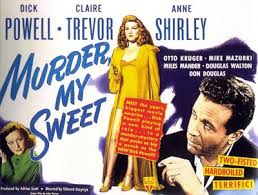
MURDER MY SWEET
US, 1944, 95 minutes, Black and White.
Dick Powell, Claire Trevor, Ann Shirley, Otto Kruger, Mike Mazurki.
Directed by Edward Dmytryk.
Murder My Sweet is a version of Raymond Chandler's Farewell My Lovely. It was one of the earliest of the film versions of Chandler's stories. Similar films were made at the time: Humphrey Bogart as Philip Marlow in The Big Sleep, Robert Montgomery in The Lady of The Lake. There have been various versions of Chandler and his popular novels over the decades. James Garner was Marlowe (1969). Elliot Gould was Marlowe in Robert Altman's updated version of The Long Goodbye. The nostalgia of the 70s recreated the atmosphere of the past especially with Robert Mitchum as Marlowe in Dick Richards' Farewell My Lovely and Michael Winner's The Big Sleep.
There are most interesting comparisons with Dmytryk's version and Dick Richards' version, especially with the contrast between the young Dick Powell and the ageing Robert Mitchum Charlotte Rampling's version of Velma more like Lauren Bacall and that of the vigorous Claire Trevor. It is interesting to look back at the private eye genre and the films made when these issues and styles were contemporary.
1. The interest in Raymond Chandler novels over the years. especially his hero Philip Marlowe? The status of Chandler's novels the interest in Marlowe and his particular characteristics and style?
2. Comment on the conventions of the private eye genre? The contributions of the 40s, especially with the works of Dashiell Hammett and Chandler? These were contemporary films of contemporary issues. The impact now?
3. The film title and the novel title? Clues as to the identity of the mystery and the killer?
4. The black and white photography, the seedy atmosphere,, the locations of the city? The style of the places shown. the world of the rich and the poor, the world of the private eye? The presentation of the police and their personalities and methods? Musical score? The interest in psychology and the special effects of Marlowe's blacking out, the special effects of his drug hallucination and the dream symbolism?
5. Dick Powell's style as Marlowe? The hard-bitten experienced private eye, the nature of his narrative and his ironic comments? The use of the flashback technique? Marlowe's skill as a private eye, strengths and weaknesses. personality, impersonal style? The people that broke through his hard shell?
6. Interest in the plot. its complexities and the various strands? The ease in following it, difficulties? Pacing and audience interest? Moving with Marlowe through the mystery ? or behind him? The quality of the mystery. the personnel involved, the clues given?
7. The figure of the private eye and his relationship to the police, to the traditional detective? The background of his being sacked from the police, down and out and seedy, the small office, the clients, the need for money and the love for money, the type of jobs undertaken, the inherent danger being suspected by the police and hounded by them? The private eye as a hero, antihero, victim?
8. The introduction of Moose, the explanation of his background? His personality, slow nature? Capacity for violence? His love for Velma and hiring Marlowe? His offering the money? His being used by Amthor?
9. The sketch of Mrs. Florian as a type, her part in the mystery?
10. The character sketch of Marriott and the revelation of his role in the mystery? The brutality of his death?
11. Amthor and his wealth, a brutal type with henchmen? His background as a doctor, psychologist, use of drugs? His use of people, especially Marriott and his use of Marlowe? The violence of his death?
12. The social observation of Grayle and his wealth? His remarriage, bond with Velma, with his daughter? His deceiving himself as regards affections? His wealth and his involvement in violence?
13. The portrait of Anne, her relationship with her father, her involvement in the mystery, her presence at Marriott's death? Her jealousy for her father? Distrust of Helen? Suspicions of Marlowe? Conventional heroine and the love interest?
14. Claire Trevor's style as Velma? The mysterious background? When did the audience suspect she was Velma? The reasons for her marriage? Her fear of the truth and the lengths that she went to conceal the truth? Her measures for enticing Marlowe into her plans? Seeming innocence, lies, helplessness? Sensuality? Her responsibility for people's deaths? Her reaction to Moose? The irony of Grayle killing her? The femme fatale?
15. How satisfactory the resolution of the plot? How satisfying? The social comment on the times? The film belonging to a particularly American genre for interest and enjoyment?
Published in Movie Reviews
Published in
Movie Reviews
Tagged under